新概念英语第二册语法名词(共37张PPT)
文档属性
| 名称 | 新概念英语第二册语法名词(共37张PPT) | 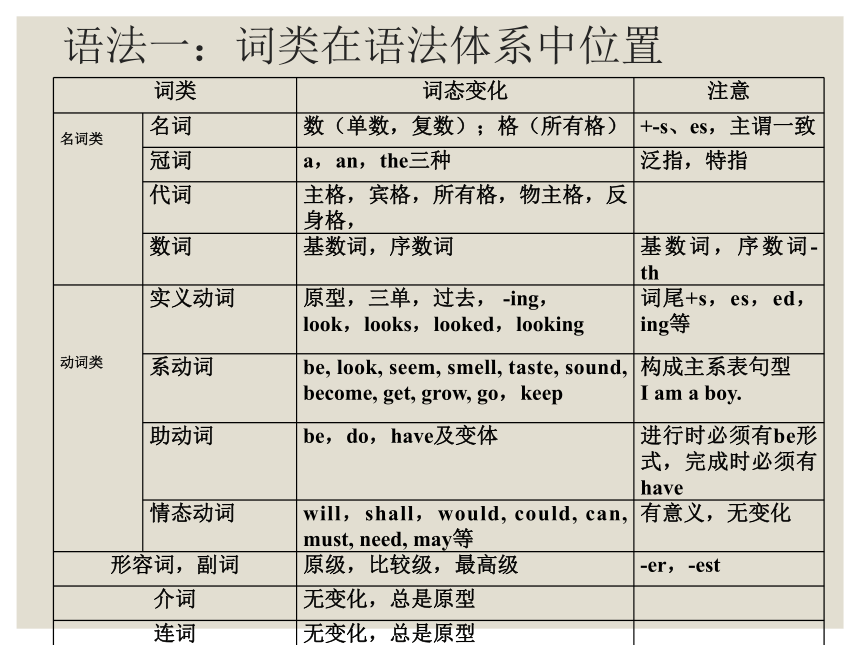 | |
| 格式 | pptx | ||
| 文件大小 | 10.9MB | ||
| 资源类型 | 教案 | ||
| 版本资源 | 新概念英语 | ||
| 科目 | 英语 | ||
| 更新时间 | 2023-06-23 18:49:21 | ||
图片预览


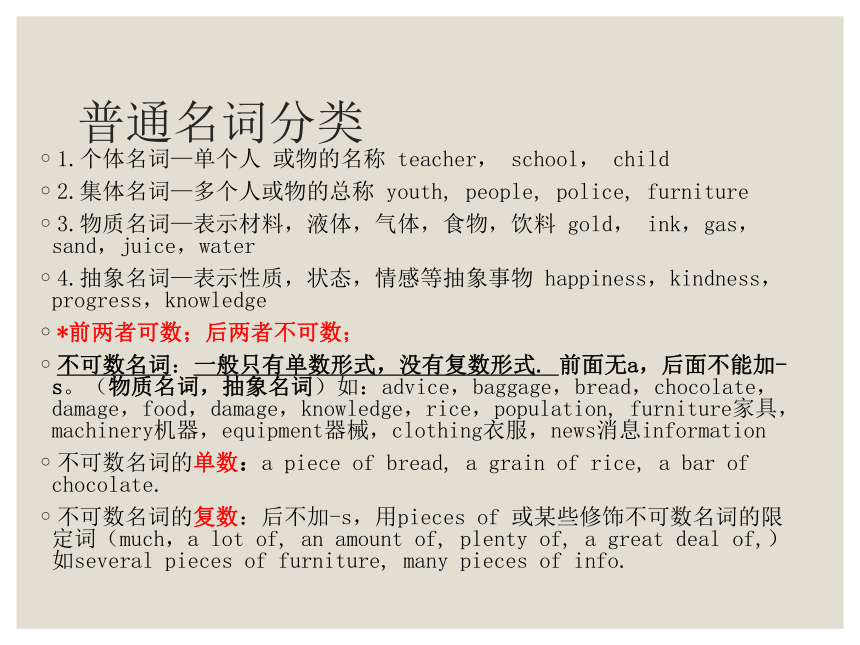

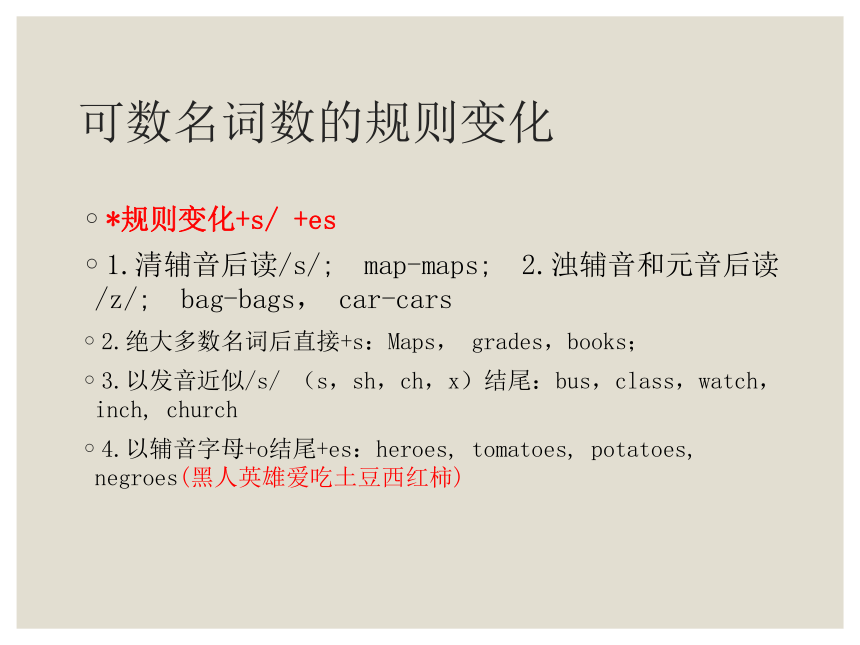

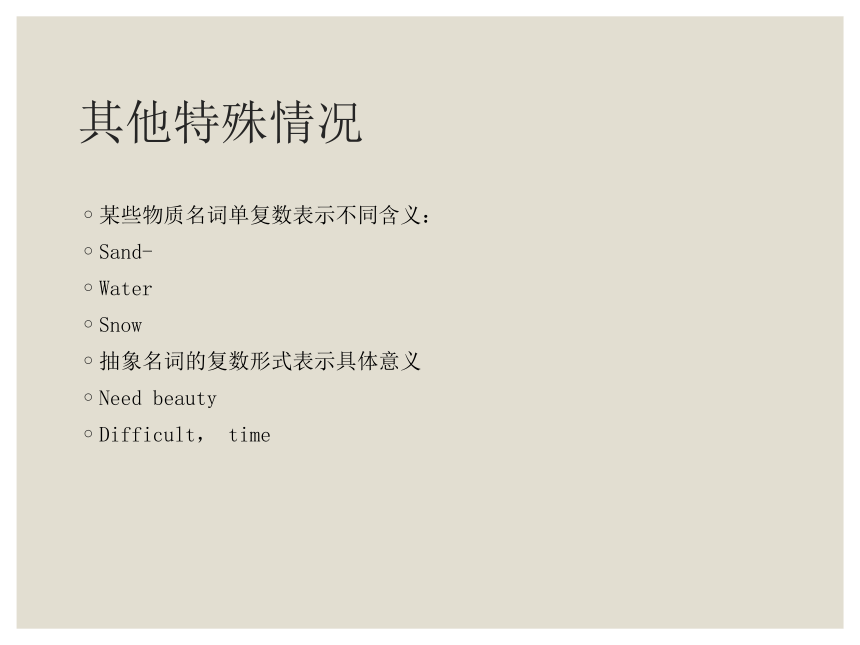
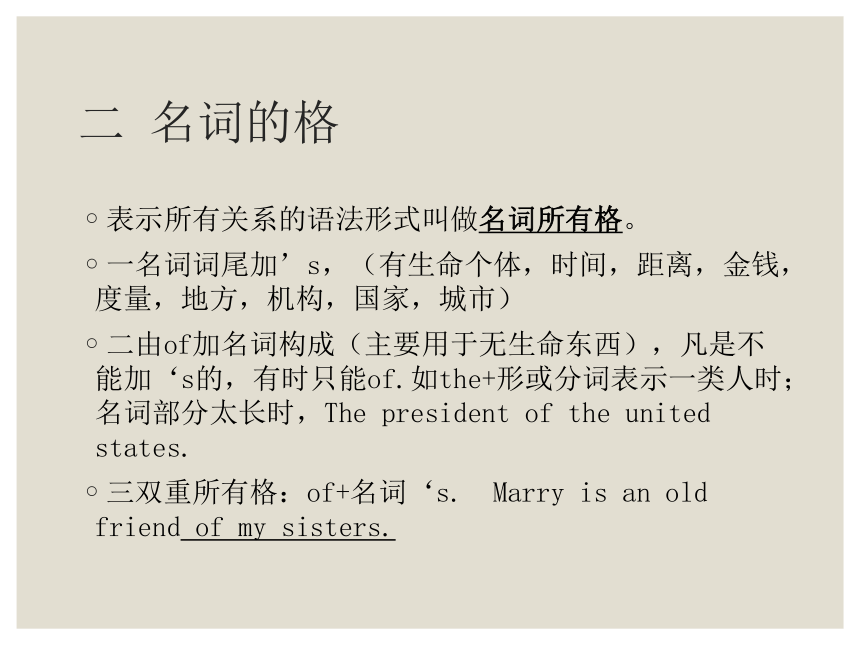
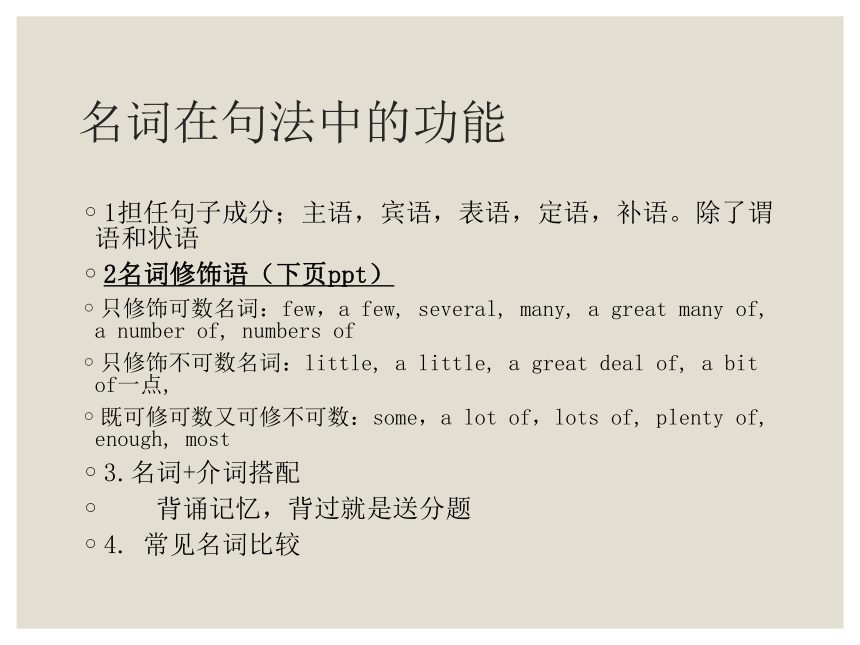



文档简介
(共37张PPT)
语法一:词类在语法体系中位置
词类 词态变化 注意
名词类 名词 数(单数,复数);格(所有格) +-s、es,主谓一致
冠词 a,an,the三种 泛指,特指
代词 主格,宾格,所有格,物主格,反身格,
数词 基数词,序数词 基数词,序数词-th
动词类 实义动词 原型,三单,过去, -ing, look,looks,looked,looking 词尾+s,es,ed,ing等
系动词 be, look, seem, smell, taste, sound, become, get, grow, go,keep 构成主系表句型
I am a boy.
助动词 be,do,have及变体 进行时必须有be形式,完成时必须有have
情态动词 will,shall,would, could, can, must, need, may等 有意义,无变化
形容词,副词 原级,比较级,最高级 -er,-est
介词 无变化,总是原型
连词 无变化,总是原型
名词的语法变化只有2个:数&格
定义:表示人、事物、抽象概念的名称词。(数,格。)
名词分类:
1.专有名词(国名/地名/人名/团体机构名称,月份/星期/节日,书/报名,电影/ 诗歌名)
专有名词各单词的首字母必须大写,虚词除外。(Beijing,the Mediterranean地中海,The United Nations,May,Sunday,Gone with the Wind,Time《时代》周刊) 谈论专有名词单复数都是耍流氓。我们讲的名词单复数都是普通名词的。
2.普通名词:可数n(个体、集体n) & 不可数n(物质,抽象)
数:表示名词的数量。单数表示单个数量,复数表示≥2个的数量。
普通名词分类
1.个体名词—单个人 或物的名称 teacher, school, child
2.集体名词—多个人或物的总称 youth, people, police, furniture
3.物质名词—表示材料,液体,气体,食物,饮料 gold, ink,gas,sand,juice,water
4.抽象名词—表示性质,状态,情感等抽象事物 happiness,kindness,progress,knowledge
*前两者可数;后两者不可数;
不可数名词:一般只有单数形式,没有复数形式. 前面无a,后面不能加-s。(物质名词,抽象名词)如:advice,baggage,bread,chocolate,damage,food,damage,knowledge,rice,population, furniture家具,machinery机器,equipment器械,clothing衣服,news消息information
不可数名词的单数:a piece of bread, a grain of rice, a bar of chocolate.
不可数名词的复数:后不加-s,用pieces of 或某些修饰不可数名词的限定词(much,a lot of, an amount of, plenty of, a great deal of,)如several pieces of furniture, many pieces of info.
可数名词单复数
集体名词单复数都可以,根据意义确定。视为整体时单数,视为成员时复数。
(集体名词的复数不能用具体数字修饰,只能在前加the表示全体,the police指全体警察the English全体英国人people本身集体名词,一个人不可以说a people,应说a person,三个人可以说3people或3 persons)
个体名词是可数名词:
单数前面+a、an; a book
复数分规则+s、es和不规则变化; 2 sisters. Pandas
可数名词数的规则变化
*规则变化+s/ +es
1.清辅音后读/s/; map-maps; 2.浊辅音和元音后读/z/; bag-bags, car-cars
2.绝大多数名词后直接+s:Maps, grades,books;
3.以发音近似/s/ (s,sh,ch,x)结尾:bus,class,watch,inch, church
4.以辅音字母+o结尾+es:heroes, tomatoes, potatoes, negroes(黑人英雄爱吃土豆西红柿)
可数名词数的不规则变化
1.以辅音字母+y 变y为i结尾的词再加es,读/z/ baby---babies,study
2.以-f,-fe结尾词,常变f为-v +es,读/vz/. Half,leaf,life,wolf,knife,shelf
3. o结尾的外来词,元音字母+o,直接+s: piano,photo,auto,zoo,radio
4. 改变元音字母:man-men;woman,foot-feet,tooth-teeth,goose-geese
5. 特殊形式:child-children,mouse-mice, phenomenon-phenomena;
datum-data,criterion-criteria,bacterium-bacteria
6. 单复数相同形式:fish, deer, sheep
7. 复合名词:没有连字符,通常把最后一个词变复数;bathroom,girl friends
有连字符,有主体名词,在主体名词后+s;没有主体名词,在最后+s;
looker-on -----lookers on ; sister in law--- sisters-in-law
其他特殊情况
某些物质名词单复数表示不同含义:
Sand-
Water
Snow
抽象名词的复数形式表示具体意义
Need beauty
Difficult, time
二 名词的格
表示所有关系的语法形式叫做名词所有格。
一名词词尾加’s,(有生命个体,时间,距离,金钱,度量,地方,机构,国家,城市)
二由of加名词构成(主要用于无生命东西),凡是不能加‘s的,有时只能of.如the+形或分词表示一类人时;名词部分太长时,The president of the united states.
三双重所有格:of+名词‘s. Marry is an old friend of my sisters.
名词在句法中的功能
1担任句子成分;主语,宾语,表语,定语,补语。除了谓语和状语
2名词修饰语(下页ppt)
只修饰可数名词:few,a few, several, many, a great many of, a number of, numbers of
只修饰不可数名词:little, a little, a great deal of, a bit of一点,
既可修可数又可修不可数:some,a lot of,lots of, plenty of, enough, most
3.名词+介词搭配
背诵记忆,背过就是送分题
4. 常见名词比较
代词
定义:代替名词以及起名词作用的短语和句子。既有名词性质,又有形容词性质。
1人称代词:主格人称代词作主语,宾格作宾语
2 指示代词:this,that,these, those
3物主代词:形词性:只能放在名词前作定语,不能单独用。My,your,
名词性:可单独用,作主,宾,表。Mine,yours,his,hers,its,ours,theirs
4 反身代词:-self,selves
5相互代词:表示相互关系,只有2个,作宾语。each other(两者),one another(三者及以上).
They sat down opposite to each other. Neighbors ought to respect one another.
6. 疑问代词:用于构成特殊疑问句,或引导名词性从句
7.不定代词:all ,both,none,every
6. 疑问代词
数词
数词(Numeral),表示数量或顺序的词叫做数词。
英语的数词可以作句子的主语、宾语、表语和定语。
数词分为两大类,即基数词和序数词。
基数词表示数目,如:one,two,three,four……;
序数词表示顺序,如:first,second,third,fourth……
序数词前一般要加the。
基数词
基数词 1-12 是独立单词,需逐个记忆。
基数词 13-19是个位数词的词干后加-teen 构成。其中 thirteen, fifteen, eighteen 变化不规则。
基数词 20-90 是在个位数词后面加 -ty 构成。其中 twenty, thirty, forty, fifty, eighty 变化不规则。
基数词 21-99 是在十位数词后面加上个位数词合成,中间加上连字符 " - " 。
例如: 21 twenty-one,95 ninety-five
序数词
一,二,三要全变;(one-first; two-second;three- third)
其余都加th, th里有例外,8去t,(eight-eighth) 9去e(nine-ninth)
字母f代ve(five-fifth; twelve-twelfth);ty变成tie(twenty-twentieth)
若要变化几十几,只变个位就可以(twenty-one-twenty-first)
倍数表达
1)倍数+形容词/副词比较级+than,用…times表示。
例如:The girl is ten times cleverer than her brother.
2)如果表示“是……两倍数”,一般用twice。
例如:My room is twice as large as yours.
3)倍数+as+形容词/副词/名词+as
例如:His apartment is three times as large as that of mine.
Americans eat twice as much protein as they actually need every day.
4)倍数+名词
例如:The volume of the Sun is about 1,300,000 times that of the earth.
年代表示法
年代用年份的阿拉伯数字加-’s或-s表示。如:
十七世纪二十年代写作1620’s或1620s。
初期、中期、末期分别用early,mid-和late表示。如:
三十年代初期写作the early thirties。
三十年代中期写作the mid-thirties。
三十年代末期写作the late thirties。
二十世纪五十年代初期写作the early 1950’s;
中期写作the mid-1950’s;
末期写作the late 1950’s。 [1]
量词
通常用来表示人、事物或动作的数量单位的词,叫做量词。
例如:a bag of (rice), a piece of (news), a cup of (tea)
英语量词特点有很多量词词组
常用量词
1. 一般性的表示个数的量词:
这一组中主要有piece, bit, item, article 等词,但piece具有独特的地位,在使用其他词的地方一般都可使用piece 代替之。比如:a piece of
meat/paper/bread/music/information/furniture/machinery
一片肉/一张纸/一片面包/一首曲子/一条信息/一件家具/一台机器等
bit :
a bit of news/wood/advice/trouble, etc.
一条消息/一块木头/一条建议/一件麻烦事等
item:
an item of news/crime/program/business, etc.
一条新闻/一宗罪行/一个项目/一笔生意等
article :
an article of export/ furniture/ clothing/ luggage, etc.
一宗出口/一件家具/一件衣服/一件行李等
2. 以形状表示个数的量词:
bar :
a bar of chocolate/candy 一块巧克力/一块糖
bunch :
a bunch of flowers/grapes/ keys
一束花/一串葡萄/一串钥匙
cluster :
a cluster of stars/flowers/animals
一群星/一束花/一群动物
ear :
an ear of corn/wheat一棒玉米/一穗麦子
head:
a head of cabbage/cauliflower/sheep
一头卷心菜/一块花菜/一头羊
slice :
a slice of meat/bread/beef
一片肉/一片面包/一块牛肉
3. 表示容积的词:
bottle:
a bottle of ink/milk/wine
一瓶酒/一瓶牛奶/一瓶葡萄酒
glass:
a glass of beer 一杯啤酒
cup:
a cup of tea 一杯茶
handful a handful of soil 一抔土
spoonful :
a spoonful of oil 一汤匙油
mouthful :
a mouthful of snow 一口雪
描述“一群”
一群人 a crowd / group / team of people;an army of people
一群牛、象、马、天鹅 a herd of cattle / elephants / horses / swans
一群鸟、鹅、母鸡、羊、燕子 a flock of birds / geese / hens / goats / swallows
一群猎狗、狼 a pack of hounds / wolves
a pair of
在英语中,成双成对的物品一般需要用a pair of:
一副眼镜 a pair of glasses
一把剪刀 a pair of scissors
一条裤子 a pair of trousers / pants
一把剪钳 a pair of pliers
一双筷子 a pair of chopsticks
名词专项练习
1. ( ) John bought___for himself yesterday.
A. two pairs of shoes B. two pair of shoe
C. two pair of shoes D. two pairs shoes
A
2. ( ) There are five___in our factory.
A. woman driver B, women driver
C. woman drivers D. women drivers
D
3. I want to buy ________.
A. two bottles of ink B. two bottle of ink
C. two bottle of inks D. two bottles of inks
A
4. Sheep _______ white and milk _______ also white.
A. is, are B. are, is
C. is, is D. are, are
C
5.They got much _____ from those new books.
A. ideas B. photos C. news D. stories
解析: much 是用来修饰不可数名词的, A B D三个选项均是可是名词的复数形式, C项为不可数名词, 因此选C.
6. An old _______ wants to see you.
A. people B. person
C. the people D. the person
解析: person 与people 都有‖人‖ 的意思, 但用法不同. ―一个人‖用 ―a person‖, ―两个人‖ 用 ―two persons‖; people 泛指 ―人们‖是集合名词,表示复数, the people 指 ―人民‖, a people 指 ―一个民族‖. 应选B。
7. ________ mothers couldn’t go to the meeting, because they have gone to Shanghai .
A. Mary and Peter’s B. Mary and Peter
C. Mary’s and Peter D. Mary’s and Peter’s
解析: 此句中 ―mothers‖是复数,表示两个人各自的母亲,因此应选D
8. He is a success as a leader but he hasn’t ________ in teaching.
A. many experiences B. much experience
C. an experience D. a lot experience
解析: experience 作 ―经验‖ 讲时是不可数名词, 作 ―经历‖讲时是可数名词. 本句中应理解为 ―经验‖,因此是不可数名词,排除 A C. 又因 a lot of , lots of, plenty of 只用于肯定句, 不用于否定句, 因此选B。
9. He doesn’t like ____ for supper.
A. chick B. chicken C. chickens D. chicks
B
10. A number of soldiers ____ at he camp gate.
A. have gathered B. has gathered C. is D. was
A
11. ____ work has been done to improve the people’s living standard.
A. Many B. A great many
C. A great deal of D. A number of
c
12. The ____ caused by carelessness ____ yesterday. Many workers were killed.
A. incident, was happened B. matter, happened C. event, was taken place D. accident, took place
D
13. The police ____ looking into the matter now.
A. be B. is C. are D. are going to
C
14. No news ____ good news.
A. is B. are C. have D. has
A
15. “Where ____ my trousers ” the boy asked.
A. is B. was C. were D. are
d
语法一:词类在语法体系中位置
词类 词态变化 注意
名词类 名词 数(单数,复数);格(所有格) +-s、es,主谓一致
冠词 a,an,the三种 泛指,特指
代词 主格,宾格,所有格,物主格,反身格,
数词 基数词,序数词 基数词,序数词-th
动词类 实义动词 原型,三单,过去, -ing, look,looks,looked,looking 词尾+s,es,ed,ing等
系动词 be, look, seem, smell, taste, sound, become, get, grow, go,keep 构成主系表句型
I am a boy.
助动词 be,do,have及变体 进行时必须有be形式,完成时必须有have
情态动词 will,shall,would, could, can, must, need, may等 有意义,无变化
形容词,副词 原级,比较级,最高级 -er,-est
介词 无变化,总是原型
连词 无变化,总是原型
名词的语法变化只有2个:数&格
定义:表示人、事物、抽象概念的名称词。(数,格。)
名词分类:
1.专有名词(国名/地名/人名/团体机构名称,月份/星期/节日,书/报名,电影/ 诗歌名)
专有名词各单词的首字母必须大写,虚词除外。(Beijing,the Mediterranean地中海,The United Nations,May,Sunday,Gone with the Wind,Time《时代》周刊) 谈论专有名词单复数都是耍流氓。我们讲的名词单复数都是普通名词的。
2.普通名词:可数n(个体、集体n) & 不可数n(物质,抽象)
数:表示名词的数量。单数表示单个数量,复数表示≥2个的数量。
普通名词分类
1.个体名词—单个人 或物的名称 teacher, school, child
2.集体名词—多个人或物的总称 youth, people, police, furniture
3.物质名词—表示材料,液体,气体,食物,饮料 gold, ink,gas,sand,juice,water
4.抽象名词—表示性质,状态,情感等抽象事物 happiness,kindness,progress,knowledge
*前两者可数;后两者不可数;
不可数名词:一般只有单数形式,没有复数形式. 前面无a,后面不能加-s。(物质名词,抽象名词)如:advice,baggage,bread,chocolate,damage,food,damage,knowledge,rice,population, furniture家具,machinery机器,equipment器械,clothing衣服,news消息information
不可数名词的单数:a piece of bread, a grain of rice, a bar of chocolate.
不可数名词的复数:后不加-s,用pieces of 或某些修饰不可数名词的限定词(much,a lot of, an amount of, plenty of, a great deal of,)如several pieces of furniture, many pieces of info.
可数名词单复数
集体名词单复数都可以,根据意义确定。视为整体时单数,视为成员时复数。
(集体名词的复数不能用具体数字修饰,只能在前加the表示全体,the police指全体警察the English全体英国人people本身集体名词,一个人不可以说a people,应说a person,三个人可以说3people或3 persons)
个体名词是可数名词:
单数前面+a、an; a book
复数分规则+s、es和不规则变化; 2 sisters. Pandas
可数名词数的规则变化
*规则变化+s/ +es
1.清辅音后读/s/; map-maps; 2.浊辅音和元音后读/z/; bag-bags, car-cars
2.绝大多数名词后直接+s:Maps, grades,books;
3.以发音近似/s/ (s,sh,ch,x)结尾:bus,class,watch,inch, church
4.以辅音字母+o结尾+es:heroes, tomatoes, potatoes, negroes(黑人英雄爱吃土豆西红柿)
可数名词数的不规则变化
1.以辅音字母+y 变y为i结尾的词再加es,读/z/ baby---babies,study
2.以-f,-fe结尾词,常变f为-v +es,读/vz/. Half,leaf,life,wolf,knife,shelf
3. o结尾的外来词,元音字母+o,直接+s: piano,photo,auto,zoo,radio
4. 改变元音字母:man-men;woman,foot-feet,tooth-teeth,goose-geese
5. 特殊形式:child-children,mouse-mice, phenomenon-phenomena;
datum-data,criterion-criteria,bacterium-bacteria
6. 单复数相同形式:fish, deer, sheep
7. 复合名词:没有连字符,通常把最后一个词变复数;bathroom,girl friends
有连字符,有主体名词,在主体名词后+s;没有主体名词,在最后+s;
looker-on -----lookers on ; sister in law--- sisters-in-law
其他特殊情况
某些物质名词单复数表示不同含义:
Sand-
Water
Snow
抽象名词的复数形式表示具体意义
Need beauty
Difficult, time
二 名词的格
表示所有关系的语法形式叫做名词所有格。
一名词词尾加’s,(有生命个体,时间,距离,金钱,度量,地方,机构,国家,城市)
二由of加名词构成(主要用于无生命东西),凡是不能加‘s的,有时只能of.如the+形或分词表示一类人时;名词部分太长时,The president of the united states.
三双重所有格:of+名词‘s. Marry is an old friend of my sisters.
名词在句法中的功能
1担任句子成分;主语,宾语,表语,定语,补语。除了谓语和状语
2名词修饰语(下页ppt)
只修饰可数名词:few,a few, several, many, a great many of, a number of, numbers of
只修饰不可数名词:little, a little, a great deal of, a bit of一点,
既可修可数又可修不可数:some,a lot of,lots of, plenty of, enough, most
3.名词+介词搭配
背诵记忆,背过就是送分题
4. 常见名词比较
代词
定义:代替名词以及起名词作用的短语和句子。既有名词性质,又有形容词性质。
1人称代词:主格人称代词作主语,宾格作宾语
2 指示代词:this,that,these, those
3物主代词:形词性:只能放在名词前作定语,不能单独用。My,your,
名词性:可单独用,作主,宾,表。Mine,yours,his,hers,its,ours,theirs
4 反身代词:-self,selves
5相互代词:表示相互关系,只有2个,作宾语。each other(两者),one another(三者及以上).
They sat down opposite to each other. Neighbors ought to respect one another.
6. 疑问代词:用于构成特殊疑问句,或引导名词性从句
7.不定代词:all ,both,none,every
6. 疑问代词
数词
数词(Numeral),表示数量或顺序的词叫做数词。
英语的数词可以作句子的主语、宾语、表语和定语。
数词分为两大类,即基数词和序数词。
基数词表示数目,如:one,two,three,four……;
序数词表示顺序,如:first,second,third,fourth……
序数词前一般要加the。
基数词
基数词 1-12 是独立单词,需逐个记忆。
基数词 13-19是个位数词的词干后加-teen 构成。其中 thirteen, fifteen, eighteen 变化不规则。
基数词 20-90 是在个位数词后面加 -ty 构成。其中 twenty, thirty, forty, fifty, eighty 变化不规则。
基数词 21-99 是在十位数词后面加上个位数词合成,中间加上连字符 " - " 。
例如: 21 twenty-one,95 ninety-five
序数词
一,二,三要全变;(one-first; two-second;three- third)
其余都加th, th里有例外,8去t,(eight-eighth) 9去e(nine-ninth)
字母f代ve(five-fifth; twelve-twelfth);ty变成tie(twenty-twentieth)
若要变化几十几,只变个位就可以(twenty-one-twenty-first)
倍数表达
1)倍数+形容词/副词比较级+than,用…times表示。
例如:The girl is ten times cleverer than her brother.
2)如果表示“是……两倍数”,一般用twice。
例如:My room is twice as large as yours.
3)倍数+as+形容词/副词/名词+as
例如:His apartment is three times as large as that of mine.
Americans eat twice as much protein as they actually need every day.
4)倍数+名词
例如:The volume of the Sun is about 1,300,000 times that of the earth.
年代表示法
年代用年份的阿拉伯数字加-’s或-s表示。如:
十七世纪二十年代写作1620’s或1620s。
初期、中期、末期分别用early,mid-和late表示。如:
三十年代初期写作the early thirties。
三十年代中期写作the mid-thirties。
三十年代末期写作the late thirties。
二十世纪五十年代初期写作the early 1950’s;
中期写作the mid-1950’s;
末期写作the late 1950’s。 [1]
量词
通常用来表示人、事物或动作的数量单位的词,叫做量词。
例如:a bag of (rice), a piece of (news), a cup of (tea)
英语量词特点有很多量词词组
常用量词
1. 一般性的表示个数的量词:
这一组中主要有piece, bit, item, article 等词,但piece具有独特的地位,在使用其他词的地方一般都可使用piece 代替之。比如:a piece of
meat/paper/bread/music/information/furniture/machinery
一片肉/一张纸/一片面包/一首曲子/一条信息/一件家具/一台机器等
bit :
a bit of news/wood/advice/trouble, etc.
一条消息/一块木头/一条建议/一件麻烦事等
item:
an item of news/crime/program/business, etc.
一条新闻/一宗罪行/一个项目/一笔生意等
article :
an article of export/ furniture/ clothing/ luggage, etc.
一宗出口/一件家具/一件衣服/一件行李等
2. 以形状表示个数的量词:
bar :
a bar of chocolate/candy 一块巧克力/一块糖
bunch :
a bunch of flowers/grapes/ keys
一束花/一串葡萄/一串钥匙
cluster :
a cluster of stars/flowers/animals
一群星/一束花/一群动物
ear :
an ear of corn/wheat一棒玉米/一穗麦子
head:
a head of cabbage/cauliflower/sheep
一头卷心菜/一块花菜/一头羊
slice :
a slice of meat/bread/beef
一片肉/一片面包/一块牛肉
3. 表示容积的词:
bottle:
a bottle of ink/milk/wine
一瓶酒/一瓶牛奶/一瓶葡萄酒
glass:
a glass of beer 一杯啤酒
cup:
a cup of tea 一杯茶
handful a handful of soil 一抔土
spoonful :
a spoonful of oil 一汤匙油
mouthful :
a mouthful of snow 一口雪
描述“一群”
一群人 a crowd / group / team of people;an army of people
一群牛、象、马、天鹅 a herd of cattle / elephants / horses / swans
一群鸟、鹅、母鸡、羊、燕子 a flock of birds / geese / hens / goats / swallows
一群猎狗、狼 a pack of hounds / wolves
a pair of
在英语中,成双成对的物品一般需要用a pair of:
一副眼镜 a pair of glasses
一把剪刀 a pair of scissors
一条裤子 a pair of trousers / pants
一把剪钳 a pair of pliers
一双筷子 a pair of chopsticks
名词专项练习
1. ( ) John bought___for himself yesterday.
A. two pairs of shoes B. two pair of shoe
C. two pair of shoes D. two pairs shoes
A
2. ( ) There are five___in our factory.
A. woman driver B, women driver
C. woman drivers D. women drivers
D
3. I want to buy ________.
A. two bottles of ink B. two bottle of ink
C. two bottle of inks D. two bottles of inks
A
4. Sheep _______ white and milk _______ also white.
A. is, are B. are, is
C. is, is D. are, are
C
5.They got much _____ from those new books.
A. ideas B. photos C. news D. stories
解析: much 是用来修饰不可数名词的, A B D三个选项均是可是名词的复数形式, C项为不可数名词, 因此选C.
6. An old _______ wants to see you.
A. people B. person
C. the people D. the person
解析: person 与people 都有‖人‖ 的意思, 但用法不同. ―一个人‖用 ―a person‖, ―两个人‖ 用 ―two persons‖; people 泛指 ―人们‖是集合名词,表示复数, the people 指 ―人民‖, a people 指 ―一个民族‖. 应选B。
7. ________ mothers couldn’t go to the meeting, because they have gone to Shanghai .
A. Mary and Peter’s B. Mary and Peter
C. Mary’s and Peter D. Mary’s and Peter’s
解析: 此句中 ―mothers‖是复数,表示两个人各自的母亲,因此应选D
8. He is a success as a leader but he hasn’t ________ in teaching.
A. many experiences B. much experience
C. an experience D. a lot experience
解析: experience 作 ―经验‖ 讲时是不可数名词, 作 ―经历‖讲时是可数名词. 本句中应理解为 ―经验‖,因此是不可数名词,排除 A C. 又因 a lot of , lots of, plenty of 只用于肯定句, 不用于否定句, 因此选B。
9. He doesn’t like ____ for supper.
A. chick B. chicken C. chickens D. chicks
B
10. A number of soldiers ____ at he camp gate.
A. have gathered B. has gathered C. is D. was
A
11. ____ work has been done to improve the people’s living standard.
A. Many B. A great many
C. A great deal of D. A number of
c
12. The ____ caused by carelessness ____ yesterday. Many workers were killed.
A. incident, was happened B. matter, happened C. event, was taken place D. accident, took place
D
13. The police ____ looking into the matter now.
A. be B. is C. are D. are going to
C
14. No news ____ good news.
A. is B. are C. have D. has
A
15. “Where ____ my trousers ” the boy asked.
A. is B. was C. were D. are
d
同课章节目录
